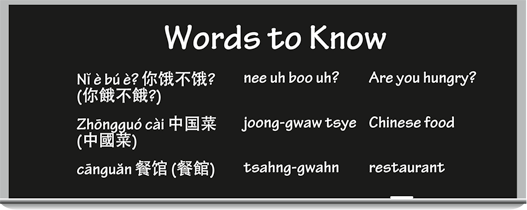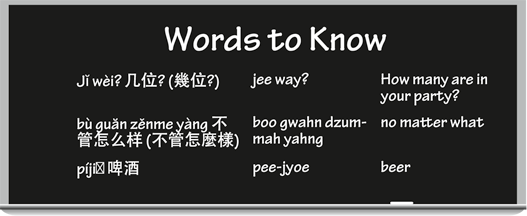Chinese For Dummies (47 page)
Read Chinese For Dummies Online
Authors: Wendy Abraham
Talkin' the Talk
Audrey and William meet after work in New York and decide where to eat.
William:
Audrey, nÇ hÇo!
Audrey, nee how!
Audrey, hi!
Audrey:
NÇ hÇo. HÇo jiÇ méi jià n.
nee how. how jyoe may jyan.
Hi there. Long time no see.
William:
NÇ Ã¨ bú è?
nee uh boo uh?
Are you hungry?
Audrey:
WÇ hÄn è. NÇ ne?
waw hun uh. nee nuh?
Yes, very hungry. How about you?
William:
WÇ yÄ hÄn è.
waw yeah hun uh.
I'm also pretty hungry.
Audrey:
WÇmen qù ZhÅngguóchéng chÄ« ZhÅngguó cà i, hÇo bù hÇo?
waw-men chyew joong-gwaw-chuhng chir joong-gwaw tsye, how boo how?
Let's go to Chinatown and have Chinese food, okay?
William:
HÇo. NÇ zhÄ«dà o ZhÅngguóchéng nÇ jiÄ cÄnguÇn hÇo ma?
how. nee jir-daow joong-waw-chuhng nah jya tsahn-gwahn how ma?
Okay. Do you know which restaurant in Chinatown is good?
Audrey:
BÄijÄ«ng kÇo yÄ dià n hÇoxià ng bú cuò.
bay-jeeng cow ya dyan how-shyang boo tswaw.
The Peking Duck place seems very good.
William:
HÇo jÃle. WÇmen zÇu ba.
how jee-luh. waw-men dzoe bah.
Great. Let's go.

 NÇ hÇo
NÇ hÇo
ä½ å¥½
(nee how), which appears in the nearby Talkin' the Talk dialogue, can be translated as
Hi.,
Hello.,
or
How are you?.
Understanding what's on the menu
Are you a vegetarian? If so, you want to order
sùcà i
ç´ è
(sue-tsye) (
vegetable dishes
). If you're a dyed-in-the-wool carnivore, however, you should definitely keep your eye on the kind of
hūncà i
è¤è
(
è·è
) (hwun-tsye) (
meat or fish dishes
) listed on the
cà idÄn
èå
(
èå®
) (tsye-dahn) (
menu
). Unlike the rice or noodles you may order, which come in individual bowls for everyone at the table, the
cà i
è
(tsye) (dishes) you order arrive on large plates, which you're expected to share with others.
You should become familiar with the basic types of food on the menu in case you have only Chinese characters and
pīnyīn
Romanization to go on. Having this knowledge allows you to immediately know which section to focus on (or, likewise, to avoid).
Take meat, for example. In English, the words for
pork, beef,
and
mutton
have no hints of the words for the animals themselves, such as
zhū
çª
(
豬
) (joo) (
pig
),
niú
ç
(nyoe) (
cow
), or
yáng
ç¾
(yahng) (
lamb
). Chinese is much simpler. Just combine the word for the animal and the word
ròu
è
(row), meaning
meat,
such as
zhū ròu
çªè
(
豬è
) (joo row)
(
pork
),
niú ròu
çè
(nyoe row) (
beef
), or
yáng ròu
ç¾è
(yahng row) (
mutton
). Voilà ! You have the dish.
Table 8-2
shows the typical elements of a Chinese menu.
Table 8-2 Typical Sections of a Chinese Menu
Chinese | Pronunciation | English |
diÇnxÄ«n | dyan-sheen | dessert |
hÇixiÄn | hi-shyan | seafood dishes |
jī lèi | jee lay | poultry dishes |
kÄiwèicà i | kye-way-tsye | appetizer |
ròu lèi | row lay | meat dishes |
sùcà i | soo-tsye | vegetarian dishes |
tÄng | tahng | soup |
yÇnlià o | een-lyaow | drinks |
Talkin' the Talk
 Ernest, Otto, and Cecilia meet at a restaurant in Shanghai after work, and a host greets them on the way in. (Track 10)
Ernest, Otto, and Cecilia meet at a restaurant in Shanghai after work, and a host greets them on the way in. (Track 10)
Host:
JÇ wèi?
jee way?
How many are in your party?
Otto:
SÄn wèi.
sahn way.
There are three of us.
The host shows them to their table. The three must now decide what to order for their meals.
Host:
QÇng zuò zhèr. Zhè shì cà idÄn.
cheeng dzwaw jar. jay shir tsye-dahn.
Please sit here. Here's the menu.
Otto:
NÇ yà o chÄ« fà n háishì yà o chÄ« mià n?
nee yaow chir fahn hi-shir yaow chir myan?
Do you want to eat rice or noodles?
Ernest:
LiÇngge dÅu kÄyÇ.
lyahng-guh doe kuh-yee.
Either one is fine.
Cecilia:
WÇ hÄn xÇhuÄn yÄoguÇ jÄ«dÄ«ng. NÇmen ne?
waw hun she-hwan yaow-gwaw jee-deeng. nee-men nuh?
I love diced chicken with cashew nuts. How about you guys?
Ernest:
DuìbùqÇ, wÇ chÄ« sù. WÇmen néng bù néng diÇn yìdiÇr dòufu?
dway-boo-chee, waw chir soo. waw-mun nung boo nung dyan ee-dyar doe-foo?
Sorry, I'm a vegetarian. Can we order some tofu?
Cecilia:
DÄngrán kÄyÇ.
dahng-rahn kuh-yee.
Of course we can.
Otto:
Bù guÇn zÄnme yà ng, wÇmen lái sÄn pÃng pÃjiÇ, hÇo bù hÇo?
boo gwahn dzummuh yahng, waw-mun lye san peeng pee-jyoe, how boo how?
No matter what, let's get three bottles of beer, okay?
Ernest:
HÄn hÇo!
hun how!
Very good!

Vegetarian's delight
If you're a vegetarian, you may feel lost when looking at a menu filled with mostly pork (the staple meat of China), beef, and fish dishes. Not to worry. As long as you memorize a couple of the terms shown in
Table 8-3
, you won't go hungry.
Table 8-3 Vegetables Commonly Found in Chinese Dishes
Chinese | Pronunciation | English |
bÅcà i | baw-tsye | spinach |
dòufu | doe-foo | bean curd |
fÄnqié | fahn-chyeh | tomato |
gÄilán | gye-lahn | Chinese broccoli |
mógū | maw-goo | mushroom |
qiézi | chyeh-dzuh | eggplant |
qÄ«ngjiÄo | cheeng-jyaow | green pepper |
sìjÃdòu | suh-jee-doe | string bean |
tÇdòu | too-doe | potato |
xÄ«lánhuÄ | she-lahn-hwah | broccoli |
yáng báicà i | yahng bye-tsye | cabbage |
yùmÇ | yew-me | corn |
zhúsÇn | joo-swoon | bamboo shoot |
When you have a good understanding of the vegetables that go into Chinese dishes, you, oh proud vegetarian, can start to order specialized vegetarian dishes at all your favorite restaurants.
Table 8-4
shows some vegetarian dishes good for a night on the town.
Table 8-4 Vegetarian Dishes
Chinese | Pronunciation | English |
dà nhuÄ tÄng | dahn-hwah tahng | egg drop soup |
gÄnbiÄn sìjìdòu | gahn-byan suh-jee-doe | sautéed string beans |
hóngshÄo dòufu | hoong-shaow doe-foo | braised bean curd in soy sauce |
suÄn là tÄng | swan lah tahng | hot-and-sour soup |
yúxiÄng qiézi | yew-shyang chyeh-dzuh | spicy eggplant with garlic |